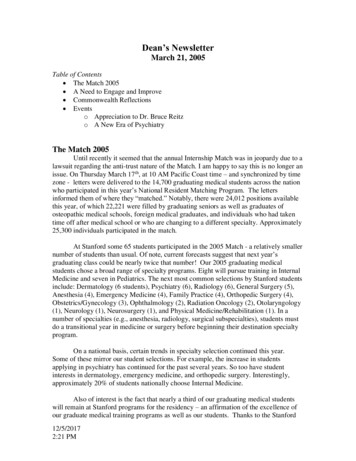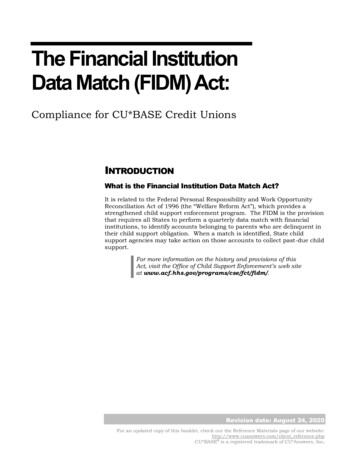
Transcription
J Cryptol 1-4Match Me if You Can: Matchmaking Encryption and ItsApplications Giuseppe Ateniese · Danilo FrancatiStevens Institute of Technology, Hoboken, NJ, USAdfrancat@stevens.eduDavid NuñezNuCypher, San Francisco, CA, USADaniele VenturiSapienza University of Rome, Rome, ItalyCommunicated by Marc FischlinReceived 26 September 2019 / Revised 2 February 2021 / Accepted 9 March 2021Online publication 21 April 2021Abstract. We introduce a new form of encryption that we name matchmaking encryption (ME). Using ME, sender S and receiver R (each with its own attributes) can bothspecify policies the other party must satisfy in order for the message to be revealed. Themain security guarantee is that of privacy-preserving policy matching: During decryption, nothing is leaked beyond the fact that a match occurred/did not occur. ME opens upnew ways of secretly communicating and enables several new applications where bothparticipants can specify fine-grained access policies to encrypted data. For instance, insocial matchmaking, S can encrypt a file containing his/her personal details and specifya policy so that the file can be decrypted only by his/her ideal partner. On the otherend, a receiver R will be able to decrypt the file only if S corresponds to his/her idealpartner defined through a policy. On the theoretical side, we define security for ME, aswell as provide generic frameworks for constructing ME from functional encryption.These constructions need to face the technical challenge of simultaneously checking thepolicies chosen by S and R, to avoid any leakage. On the practical side, we construct anefficient identity-based scheme for equality policies, with provable security in the random oracle model under the standard BDH assumption. We implement and evaluate ourscheme and provide experimental evidence that our construction is practical. We alsoapply identity-based ME to a concrete use case, in particular for creating an anonymousbulletin board over a Tor network.Keywords. Secret handshake, Attribute-based encryption, Social matchmaking, Tor. An abridged version of this paper appears in the Proceedings of the 39th International CryptologyConference (CRYPTO 2019). The Author(s), under exclusive licence to International Association for Cryptologic Research 2021
16 Page 2 of 50G. Ateniese et al.1. IntroductionIntelligence operations often require secret agents to communicate with other agentsfrom different organizations. When two spies meet to exchange secrets, they use a typeof secret handshake to ensure that the parties participating in the exchange are the onesintended. For example, an FBI agent may want to communicate only with CIA agents,and if this is not the case, the communication should drop without revealing membershipinformation and why the communication failed. This form of live drop communication,1when parties are online and interact, has been implemented in cryptography and it isreferred to as secret handshake (SH) protocol [10]. In SH, two parties agree on the samesecret key only if they are both from the same group. Privacy is preserved in the sensethat, if the handshake fails, nobody learns anything relevant other than the participantsare not in the same group. In SH with dynamic matching [7], groups and roles can evenbe determined just before the protocol execution.SH can be thought of as an evolution of traditional key exchange protocols, where protecting privacy of the participants assumes an essential role. As any other key agreementprotocol, SH is inherently interactive and its purpose is for the parties to converge on asecret key. A natural question is whether there exists a non-interactive version of SH, ina similar way as ElGamal public-key encryption can be interpreted as a non-interactiveversion of the classical Diffie–Hellman key exchange. This new cryptographic primitivewould allow senders to encrypt messages offline given only the public key of the receiver,thus getting rid of real-time interactions, while at the same time providing strong privacyguarantees for time-delayed communications such as email. Non-interactivity mitigatesor prevents traffic analysis which affects all SH protocols when deployed within a network environment (see, e.g., [7]). In particular, increased traffic between nodes maysignal to an adversary that the SH protocol was successful, even though the nodes’group affiliations and roles remain private.Non-interactive SH is even more relevant if we consider that the most common methodof espionage tradecraft is the dead drop one,1 which maintains operational security byusing a secret location for the exchange of information, thus relieving the agents frommeeting in person. Unfortunately, dead-drop communication cannot be captured by anyexisting cryptographic primitive, since it requires a form of expressiveness that is notcurrently provided by encryption and its more advanced forms.Matchmaking encryption In this paper, we are revamping the encryption primitive andintroducing a new concept termed “Matchmaking Encryption,” or ME. In ME, a trustedauthority generates encryption and decryption keys associated, respectively, to attributesof the sender and the receiver. The authority also generates an additional decryption keyfor the receiver, associated with an arbitrary policy of its choice. The sender of themessage can specify on the fly an arbitrary policy the receiver must satisfy in orderfor the message to be revealed. The guarantee is now that the receiver will obtain themessage if and only if a match occurs (i.e., the sender’s attributes match the receiver’spolicy and vice-versa). Nothing beyond that is leaked; furthermore, the sender’s attributes1 See https://en.wikipedia.org/wiki/Dead drop.
Match Me if You Can: Matchmaking Encryption and Its ApplicationsPage 3 of 50 16are certified by the authority, so that no malicious sender can forge a valid ciphertextwhich embeds fake attributes.For instance, the sender, during encryption, can specify that the message is intendedfor an FBI agent that lives in NYC. The receiver, during decryption, can also specify thathe wants to read messages only if they come from CIA agents. If any of these two policiesis not satisfied, the message remains secret, but nobody learns which policy failed. In thisvein, ME can be seen as a non-interactive version of SH, but with much more enhancedfunctionality. Indeed, an SH works only for groups and roles, while attribute-based keyagreements [29] do not consider privacy. We refer the reader to Sect. 1.3 for a comparisonbetween ME and other primitives in the realm of attribute-based cryptography.Other killer applications of ME are those where the receiver must be sheltered fromthe actual content of messages to avoid liability, inconvenience or inappropriateness. MEnaturally tackles social matchmaking confidentiality, where potential partners open filesintended for them but only if they contain the traits of the desired person; if decryptionfails, nobody learns why, so that privacy is preserved. Encrypting bids (or votes) underME provides an exciting twist to well-studied problems. Bidders send private bids toa collector and specify the conditions under which the encryption should be opened.The collector opens only the bids that match specific requirements. If decryption fails,the collector does not learn why, and the actual bid (or vote) remains sealed. ME avoidsexposing information connected to unlooked-for bids which could influence the receiverand adversely affect the bidding process outcome.ME also supports marginalized and dissident communities in authoritarian countries.It can act as an enabler for journalists, political activists, and minorities in free-speechtechnical applications such as SecurePost [47] that provides verified group anonymity.Indeed, in their thorough study [47], the authors reveal that, in authoritarian countries,anonymous communication may not be credible and cannot be trusted since sourcesare unknown.2 ME provides a comprehensive technical solution for censorship-resistantcommunication while providing source authenticity and strong privacy guarantees thatcannot be obtained with existing tools. For instance, the ability to check ciphertextsagainst a policy before decryption allows journalists or activists to vet messages andavoid exposure to unwanted information that would make them liable. To this end, inSect. 6, we introduce and implement a privacy-preserving bulletin board that combinesTor hidden services with ME to allow parties to collect information from anonymousbut authentic sources.1.1. Our ContributionsWe initiate a systematic study of ME, both in terms of definitions and constructions. Ourmain contributions are summarized below.Syntax of ME In ME, a trusted authority publishes a master public key mpk, associatedwith a master secret key msk. The master secret key msk is used by the authority togenerate three types of keys: (i) An encryption key ek σ , associated with attributes σ forthe sender (created using an algorithm SKGen); (ii) A decryption key dkρ , associated2 See t-trustworthy.
16 Page 4 of 50G. Ateniese et al.with attributes ρ for the receiver (created using an algorithm RKGen); (iii) A decryptionkey dk S , associated with a policy S that the sender’s attributes should satisfy, but that ischosen by the receiver (created using an algorithm PolGen).A sender with attributes σ , and corresponding encryption key ekσ obtained from theauthority, can encrypt a plaintext m by additionally specifying a policy R (chosen on thefly), thus yielding a ciphertext c that is associated with both σ and R. Finally, the receivercan attempt to decrypt c using keys dkρ and dk S : In case of a match (i.e., the attributesof both parties satisfy the counterparty’s policy), the receiver obtains the plaintext, andotherwise an error occurs.Security of ME We consider two properties termed privacy, and authenticity. On roughterms, privacy looks at the secrecy of the sender w.r.t. the plaintext m, the chosen policyR, and its attributes σ , whenever a malicious receiver, possessing decryption keys forseveral attributes ρ and policies S: Can’t decrypt the ciphertext (“mismatch condition”), i.e., either the sender’sattributes do not satisfy the policies held by the receiver (S(σ ) 0), or the receiver’sattributes do not satisfy the policy specified by the sender (R(ρ) 0). Can decrypt the ciphertext (“match condition”), i.e., both the sender’s and thereceiver’s attributes satisfy the corresponding policy specified by the counterpart(R(ρ) 1 and S(σ ) 1). Of course, in such a case the receiver is allowed to learnthe plaintext.On the other hand, authenticity says that an attacker not possessing attributes σ shouldnot be able to create a valid ciphertext (i.e., a ciphertext not decrypting to ) w.r.t. anyaccess policy that is satisfied by σ .Black-box constructions It turned out that building matchmaking encryption is quitedifficult. While a compiler turning key agreement into public-key encryption exists (e.g.,Diffie–Hellman key exchange into ElGamal public-key encryption), there is no obviousway of building ME from SH, even by extending the model of SH to include attributes andpolicies in order to achieve something akin to attribute-based key agreement protocols.The main technical challenge is to ensure that the policies established by the sender andreceiver are simultaneously checked to avoid any leakage. This simultaneity requirementis so elusive that even constructions combining attribute-based encryption (ABE) withauthentication mechanisms fail to achieve it (more on this later).Our first technical contribution is a construction of an ME for arbitrary policies basedon three tools: (i) an FE scheme for randomized functionalities [3] (rFE), (ii) digital signatures, and (iii) non-interactive zero-knowledge (NIZK) proofs. When using the rFEscheme from [3], we can instantiate our scheme assuming the existence of either semantically secure public-key encryption schemes and low-depth pseudorandom generators, orconcrete assumptions on multi-linear maps, or polynomially secure indistinguishabilityobfuscation (iO).This construction satisfies only security against bounded collusions, where there is ana-priori upper bound on the number of queries a malicious receiver can make to oraclesRKGen and PolGen. We additionally give a simpler construction of ME for arbitrarypolicies that even achieves full security (i.e., security against unbounded collusions),
Match Me if You Can: Matchmaking Encryption and Its ApplicationsPage 5 of 50 16albeit under stronger assumptions. In particular, we replace rFE with 2-input functionalencryption (2FE) [28]. When using the 2FE scheme by Goldwasser et al. [28], we caninstantiate this construction based on sub-exponentially secure iO.Being based on strong assumptions, the above constructions should be mainly understood as feasibility results showing the possibility of constructing ME for arbitrarypolicies. It is nevertheless worth pointing out a recent construction of iO based onLWE, bilinear maps, and weak pseudorandomness [6], which avoids multi-linear maps.Additionally, Fisch et al. [23] show how to implement efficiently FE and 2FE usingIntel’s Software Guard Extensions (SGX), a set of processors allowing for the creationof isolated execution environments called enclaves. At a high level, in their practicalimplementation, a functional decryption key sk f consists of a signature on the functionf , while messages are encrypted using standard PKE. In order to run the decryptionalgorithm, a client sends sk f together with ciphertext c to a decryption enclave, whichfirst checks if the signature is valid (i.e., the function evaluation has been authorized bythe authority), and if so it decrypts c by using the corresponding secret key, and outputsthe function f evaluated on the plaintext. Lastly, the enclave erases its memory. Thisapproach can be applied directly to FE, 2FE, and even rFE for arbitrary functionalities,which, thanks to our results, makes ME for arbitrary policies practical in the trustedhardware setting. However, we point out that trusted hardware can be used to directlyimplement ME (without implementing FE first) by simply programming the decryptionenclave to work as expected in the ME, i.e., return the encrypted message if and only ifboth the sender’s and the receiver’s attributes satisfy the corresponding policy (R(ρ) 1and S(σ ) 1).The identity-based setting Next, we turn to the natural question of obtaining efficientME in restricted settings. In particular, we focus on the identity-based setting whereaccess policies are simply bit-strings representing identities (as for standard identitybased encryption). This yields identity-based ME (IB-ME). For this setting, we providean efficient construction that we prove secure in the random oracle model (ROM), basedon the standard bilinear Diffie–Hellman assumption (BDH) over bilinear groups.Recall that in ME the receiver needs to obtain from the authority a different key foreach access policy S. While this requirement is perfectly reasonable in the general case,where the policy might consist of the conjunction of several attributes, in the identitybased setting a receiver that wants to receive messages from several sources must obtainone key for each source. As this would not scale well in practice, we change the syntax ofIB-ME and remove the PolGen algorithm. In particular, the receiver can now specify onthe fly an identity string snd (playing the role of the access policy S) that is directly inputto the decryption algorithm (together with the secret key associated with the receiver’sidentity).While the above modification yields much more efficient IB-ME schemes, it comeswith the drawback that an adversary in the privacy game can try to unlock a givenciphertext using different target identities snd chosen on the fly. The latter yields simpleattacks that required us to tweak the definition of privacy in the identity-based settingslightly. We refer the reader to Sect. 5 for more details.
16 Page 6 of 50G. Ateniese et al.Table 1. Results achieved in this work. † Security only holds in the identity-based setting.Section 4Section 5Section 4.2Section 3.2TypePrivacyAuthenticityAssumptionsMEIB-MEMEA-ME ‡ † ‡ † rFE Signatures NIZKBDH (RO model)2FE Signatures NIZKFE Signatures NIZK‡ Security only holds in case of bounded collusionsConcrete use case and implementation We give evidence of the practical viabilityof our IB-ME construction by providing a prototype implementation in Python. Ourexperimental evaluation can be found in Sect. 6. There, we also detail a concrete use casewhere IB-ME is used in order to realize a prototype of a new privacy-preserving bulletinboard that is run on the Tor network [58]. Our system allows parties to communicateprivately, or entities such as newspapers or organizations to collect information fromanonymous sources.A public bulletin board is essentially a broadcast channel with memory. Messagescan be encrypted under ME so that their content is revealed only in case of a policymatch. The privacy-preserving feature of ME ensures that, if decryption fails, nobodylearns which policies were not satisfied. This effectively creates secure and private virtualrooms or sub-channels.Arranged ME In ME a receiver can obtain independent decryption keys for its attributesand policies. Note that these keys can be arbitrarily combined during decryption. Forthis reason, we also consider an alternative flavor of ME, called arranged matchmakingencryption (A-ME), where there is a single decryption key dk ρ,S that describes simultaneously the receiver’s attributes ρ and the policy S chosen by the receiver. Thus, anA-ME scheme does not come with a PolGen algorithm. This feature makes sense inapplications where a receiver has different attributes, each bearing different restrictionsin terms of access policies. A-ME is simpler to construct, in fact we show how to obtainA-ME for arbitrary policies from FE for deterministic functionalities, digital signatures,and NIZK proofs.See Table 1 for a summary of our constructions in terms of assumptions and fordifferent flavors of ME.1.2. Technical ApproachAt first glance, it may seem that FE trivially implies ME (similarly to how FE impliesboth ciphertext-policy ABE [15] (CP-ABE) and key-policy ABE [33] (KP-ABE)). Thisbecause FE permits to generate a decryption key dk f associated with a functionality f ,in such a way that decrypting a ciphertext c, with underlying plaintext x, under dk f ,yields f (x) (and nothing more). On the other hand, ME deals with a weaker decryptionfunctionality, i.e., it outputs the plaintext x only if a match occurs. Nevertheless, therelation between ME and FE results to be much more tangled. The decryption process ofME involves two decryption keys dkρ and dk S —the first associated with the receiver’s
Match Me if You Can: Matchmaking Encryption and Its ApplicationsPage 7 of 50 16attributes ρ and the second associated with the receiver’s policy S—and, at the sametime, must protect the sender’s privacy. In FE, instead, the decryption of a ciphertextinvolves a single decryption key dk f for a functionality f . For this reason, FE alonefails to implement the privacy-preserving two-key decryption algorithm needed for ME.In what follows, we present two unsuccessful attempts to constructing ME based on FE,naturally leading to our secure constructions.* First attempt. A first natural approach would be to construct an ME scheme bycombining two distinct FE schemes. The idea is to apply sequentially two functionalitiesf 1 and f 2 , where the first functionality checks whether the sender’s policy R is satisfied,whereas the second functionality checks whether the receiver’s policy S is satisfied. Morein detail, let f 1 and f 2 be the following functions:f ρ1 (R, c) c, if R(ρ) 1 , otherwisef S2 (σ, m) m, if S(σ ) 1 , otherwisewhere R(ρ) 1 (resp. S(σ ) 1) means that receiver’s attributes ρ (resp. sender’sattributes σ ) satisfy the sender’s policy R (resp. receiver’s policy S). A sender nowencrypts a message m under attributes σ by first encrypting (σ, m) under the second FEscheme, and thus it encrypts the corresponding ciphertext concatenated with the policyR under the first FE scheme. The receiver first decrypts a ciphertext using secret keydk ρ associated with function f ρ1 , and then it decrypts the obtained value using secretkey dk S associated with function f S2 .While “semantic security” of the underlying FE schemes computationally hides theplaintext of the resulting ME scheme, privacy is not guaranteed completely: In fact,when the first encrypted layer decrypts correctly (resp. does not decrypt correctly), areceiver infers that the sender’s attributes σ match (resp. do not match) the policy S.Second attempt One could think to salvage the above construction as follows. Eachfunction f i returns a random key ri in case the corresponding policy (i.e., the policychecked by function f i ) is satisfied, and otherwise it returns a random value generatedby running a secure PRF F. Both partial keys r1 , r2 are then needed to unmask the stringr1 r2 m, which is included in the ciphertext.More precisely, consider functions f ρ1 (R, r1 , k1 ) and f S2 (σ, r2 , k2 ), such that f ρ1 (R, r1 , k1 )(resp. f S2 (σ, r2 , k2 )) returns r1 (resp. r2 ) if ρ satisfies R (resp. σ satisfies S); otherwise,it returns Fk1 (ρ) (resp. Fk2 (S)), where k1 (resp. k2 ) is a key for the PRF F. An encryption of message m w.r.t. attributes σ and policy R would now consist of three values(c1 , c2 , c3 ), where c1 is an encryption of (R, r1 , k1 ) under the first FE scheme, c2 is anencryption of (σ, r2 , k2 ) under the second FE scheme, and finally c3 r1 r2 m. Areceiver (with keys dk ρ and dk S associated with functions f ρ1 and f S2 as before) woulddecrypt c1 and c2 using dk ρ and dk S , and finally xor the outputs between them and withc3 .As before, “semantic security” still follows from the security of the two FE schemes.Furthermore, it might seem that privacy is also satisfied because, by security of the PRF,it is hard to distinguish whether the decryption of each ci yields the random string ri (i.e.,
16 Page 8 of 50G. Ateniese et al.there was a match) or an output of Fki (i.e., there was no match). However, a maliciousreceiver possessing distinct attributes ρ and ρ , such that both satisfy the policy R, isable to figure out whether the sender’s policy is matched by simply decrypting c1 twice(using attributes ρ and ρ ) and comparing if the decryption returns twice the same value(i.e., r1 ). A similar attack can be carried out using two different keys for distinct policiesS and S , such that both policies are satisfied by the attributes σ .ME from 2FE Intuitively, in order to avoid the above attacks, we need to check simultaneously that S(σ ) 1 and R(ρ) 1. 2FE comes handy to solve this problem, atleast if one is willing to give up on authenticity. Recall that in a 2FE scheme we canassociate secret keys with 2-ary functionalities, in such a way that decrypting ciphertexts c0 , c1 computed using independent keys ek0 , ek 1 , and corresponding to plaintextsx0 , x1 , yields f (x0 , x1 ) (and nothing more).Wlog., we reserve the 1st slot to the sender, while the 2nd slot is reserved to the receiver;the administrator gives the key ek 0 to the sender. The sender now encrypts a messagem under attributes σ and policy R by computing Enc(ek 0 , (σ, R, m)), which yields aciphertext c0 for the first input of the function f . The receiver, as usual, has a pair ofdecryption keys dk ρ , dk S obtained from the administrator; here, dk S Enc(ek 1 , S) c1 is an encryption of S under key ek 1 . Hence, the receiver runs Dec(dk ρ , c0 , c1 ), wheredk ρ is associated with the function f ρ ((m, σ, R), S) that returns m if and only if bothR(ρ) 1 and S(σ ) 1 (i.e., a match occurs).On rough terms, privacy follows by the security of the underlying 2FE scheme, whichguarantees that the receiver learns nothing more than the output of f . Unfortunately, thisconstruction does not immediately satisfy authenticity. To overcome this limitation, wetweak it as follows. First, we let the sender obtain from the authority a signature s on itsown attributes σ ; the signature is computed w.r.t. a verification key that is included inthe public parameters of the scheme. Second, during encryption, the sender computesthe ciphertext c0 as above, but now additionally proves in zero knowledge that it knowsa valid signature for the attributes that are hidden in the ciphertext. As we show, thismodification allows us to prove authenticity, while at the same time preserving privacy.We refer the reader to Sect. 4.2 for the formal proof.ME from rFE In Sect. 4, we give an alternative solution that combines rFE and FE (andthus can be instantiated from weaker assumptions). Recall that rFE is a generalizationof FE that supports randomized functionalities. In what follows, we write f 1 for therandomized functionality supported by the rFE scheme, and f 2 for the deterministicfunctionality supported by the plain FE scheme. The main idea is to let the senderencrypt (m, σ, R) under the rFE scheme. We then consider the randomized function f ρ1that checks if ρ satisfies R: In case a match occurs (resp. does not occur), it returns anencryption of (m, σ ) (resp. of ( , ), where denotes garbage) for the second functionf S2 that simply checks whether the policy S is satisfied or not. The receiver decryptionkeys are the keys dk ρ , dk S associated with the functions f ρ1 and f S2 .Roughly speaking, since the randomized function f 1 passes encrypted data to f 2 , amalicious receiver infers nothing about the satisfiability of policy R. On the other hand,
Match Me if You Can: Matchmaking Encryption and Its ApplicationsPage 9 of 50 16the satisfiability of S remains hidden, as long as the FE scheme for the function f 2 issecure.While the above construction does not directly satisfy authenticity, we can show thatthe same trick explained above for the 2FE-based scheme works here as well.A-ME from FE Recall that the difference between ME and A-ME lies in the numberof decryption keys: While in ME there are two distinct keys (one for the policy S, andone for the attributes ρ), in A-ME there is a single decryption key dk ρ,S that representsboth the receiver’s attributes ρ and the policy S.As a result, looking at our construction of ME from 2FE, we can now hard-code thepolicy S (together with the attributes ρ) into the function, which allows us to replace 2FEwith plain FE. This way, each A-ME decryption key dk ρ,S is the secret key correspondingto the function f ρ,S for the FE scheme. The security proof, which appears in Sect. 4.3,only requires FE with game-based security [15], which in turn can be instantiated undermuch weaker assumptions.IB-ME Above, we mentioned that the natural construction of ME where a ciphertextmasks the plaintext m with two distinct pads r1 , r2 —where r1 , r2 are re-computable bythe receiver as long as a match occurs—is insecure. This is because the expressivenessof ME allows us to have two distinct attributes ρ and ρ (resp. two distinct policies S andS ) such that both satisfy the sender’s policy R (resp. both are satisfied by the sender’sattributes σ ).The main idea behind our construction of IB-ME (cf. Sect. 5) under the BDH assumption is that the above attack does not work in the identity-based setting, where eachreceiver’s policy S (resp. receiver’s policy R) is satisfied only by the attribute σ S(resp. ρ R). This means that an encryption m r1 r2 yields an efficient IB-ME aslong as the random pad r2 (resp. r1 ) can be re-computed by the receiver if and only ifits policy S is satisfied (resp. its attributes ρ satisfy the sender’s policy). On the otherhand, if S is not satisfied (resp. ρ does not satisfy the sender’s policy), the receiverobtains a pad r2 (resp. r1 ) that is completely unrelated to the real r2 (resp. r1 ). In ourscheme, we achieve the latter by following a similar strategy as in the Boneh–FranklinIBE construction [14].1.3. Related WorkSecret handshakes and affiliation-hiding group key exchange Introduced by Balfanz etal. [10], an SH allows two members of the same group (identified by a certificate issuedby the authority) to secretly authenticate to each other and agree on a symmetric key.During the protocol, a party can additionally specify the precise group identity (e.g.,role) that the other party should have.SH preserves the privacy of the participants, meaning that when the handshake issuccessful they only learn that they both belong to the same group (yet, their identitiesremain secret), whereas they learn nothing if the handshake fails. Subsequent work inthe area [7,16,34,35,56,57,61,62,68] focused on improving on various aspects of SH,including members’ privacy and expressiveness of the matching policies (i.e., attributebased SH).
16 Page 10 of 50G. Ateniese et al.Affiliation-hiding authenticated key exchange (AH-AKE) [36–38] protocols extendthe privacy guarantees (of SH) also to the communication sessions that will eventuallyfollow the SH authentication session. In more detail, Jarecki et al. [36] and Jareckiand Liu [38] consider AH-AKE protocols in a multi-party and two-party (unlinkable)setting, respectively. Jarecki et al. [37] strengthen the privacy guarantees of AH-AKEprotocols by considering perfect forward secrecy (in the presence of future participantscorruptions). Other relevant works focus on other security aspects of AH-AKE such asmalicious authorities [45,46], efficiency [42–44], and asymmetric AH-AKE [66,67].In this vein, ME can be thought of as a non-interactive SH (or a non-interactive AHAKE).
apply identity-based ME to a concrete use case, in particular for creating an anonymous bulletin board over a Tor network. Keywords. Secret handshake, Attribute-based encryption, Social matchmaking, Tor. An abridged version of this paper appears in the Proceedings of the 39th International Cryptology Conference (CRYPTO 2019).











